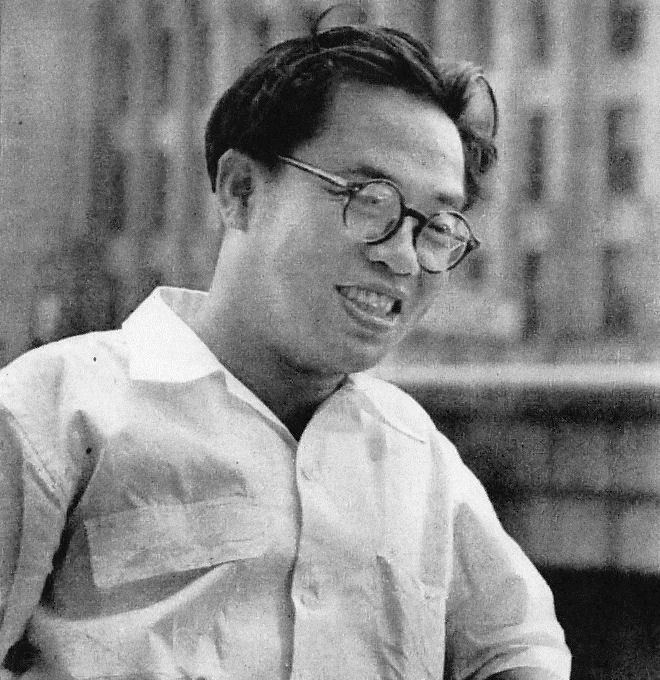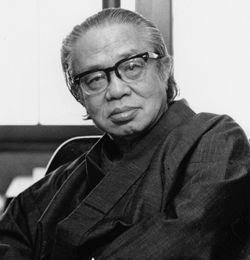Occupation Writer Name Seicho Matsumoto | Nationality Japanese Role Writer | |
 | ||
Genre Detective fictionnon-fictionAncient history Died August 4, 1992, Tokyo, Japan Movies Castle of Sand, Zero Focus, The Demon, Voice Without a Shadow, The Street of Desire, Meiso chizu Parents Minetaro Matsumoto, Tani Okada Books Inspector Imanishi Investigates, Points & Lines, The Voice and Other Stories, Suna no Utsuwa Similar People Shinobu Hashimoto, Yoji Yamada, Seishi Yokomizo, Yasushi Akutagawa, Ken Ogata | ||
Rese a el expreso de tokio de seicho matsumoto
Seichō Matsumoto (松本 清張, Matsumoto Seichō, December 21, 1909 – August 4, 1992) was a Japanese writer.
Contents
- Rese a el expreso de tokio de seicho matsumoto
- seicho matsumoto house seicho matsumoto lived a long time ago
- Biography
- Works in English translation
- Awards
- Novels
- Short stories
- Japanese Modern history
- Ancient history
- Film Adaptations
- References

Seichō's works created a new tradition of Japanese crime fiction. Dispensing with formulaic plot devices such as puzzles, Seichō incorporated elements of human psychology and ordinary life. In particular, his works often reflect a wider social context and postwar nihilism that expanded the scope and further darkened the atmosphere of the genre. His exposé of corruption among police officials as well as criminals was a new addition to the field. The subject of investigation was not just the crime but also the society in which the crime was committed.

The self-educated Seichō did not see his first book in print until he was in his forties. He was a prolific author, he wrote until his death in 1992, producing in four decades more than 450 works. Seichō's mystery and detective fiction solidified his reputation as a writer at home and abroad. He wrote historical novels and nonfiction in addition to mystery/detective fiction.

He was awarded the Akutagawa Prize in 1952 and the Kikuchi Kan Prize in 1970, as well as the Mystery Writers of Japan Award in 1957. He chaired the president of Mystery Writers of Japan from 1963 to 1971.
Credited with popularizing the genre among readers in his country, Seichō became his nation's best-selling and highest earning author in the 1960s. His most acclaimed detective novels, including Ten to sen (1958; Points and Lines, 1970); Suna no utsuwa (1961; Inspector Imanishi Investigates, 1989) and Kiri no hata (1961; Pro Bono, 2012), have been translated into a number of languages, including English.
He collaborated with film director Yoshitarō Nomura on adaptations of eight of his novels to film, including Castle of Sand.
seicho matsumoto house seicho matsumoto lived a long time ago
Biography
Seichō was born in the city of Kokura, now Kokura Kita ward, Kitakyushu, Fukuoka prefecture, on the island of Kyushu in Japan in 1909. His real name was Kiyoharu Matsumoto, he later adopted the pen name of Seichō Matsumoto; "Seichō" is the Sino-Japanese reading of the characters of his given name. A product of humble origins, he was his parents' only child. Following his graduation from elementary school, Seichō found employment at a utility company. As an adult he designed layouts for the Asahi Shinbun in Kyushu. His work in the advertising department was interrupted by service in World War II. A medical corpsman, Seichō spent much of the war in Korea. He resumed work at the Asahi Shinbun after the war, transferring to the Tokyo office in 1950.
Though Seichō attended neither secondary school nor university, he was well read. As a rebellious teenager, he read banned revolutionary texts as part of a political protest. This act so enraged Seichō's father that he destroyed his son's collection of literature. Undeterred, the young Seichō sought award-winning works of fiction and studied them intently. His official foray into literature occurred in 1950 when Shukan Asahi magazine hosted a fiction contest. He submitted his short story "Saigō satsu" (Saigō's Currency) and placed third in the competition. With three generations dependent on him (he supported his parents as well as his wife and children), Seichō welcomed the prize money. His modest success and the encouragement of fellow writers fueled his efforts. Within six years he had retired from his post at the newspaper to pursue a full-time career as a writer.
Renowned for his work ethic, Seichō wrote short fiction while simultaneously producing multiple novels, at one point as many as five concurrently, in the form of magazine serials. Many of Seichō's crime stories debuted in periodicals, among them the acclaimed "Harikomi" (The Chase), in which a woman reunites with her fugitive lover while police close in on her home. As is true of much of Seichō's fiction, this psychological portrait reveals more about the characters than the crime.
For his literary accomplishments, Seichō received the Mystery Writers of Japan Prize, Kikuchi Kan Prize, the Yoshikawa Eiji Prize for Literature, all awards bestowed on writers of popular fiction. In 1952 he was awarded the prestigious Akutagawa Prize for "Aru 'Kokura-nikki' den" (The Legend of the Kokura-Diary). Considered Seichō's best story, it features a disabled but diligent protagonist who seeks entries that are missing from the diary of author and army medical physician Mori Ōgai.
A lifelong activist, Seichō voiced anti-American sentiment in some of his writings, but he was equally critical of his own society. Many of his works of fiction and nonfiction reveal corruption in the Japanese system. A political radical despite (or perhaps in reaction to) growing up in a conformist society, Seichō associated with like-minded individuals. In 1968 he traveled to communist Cuba as a delegate of the World Cultural Congress and later that same year ventured to North Vietnam to meet with its president. Though he continued to write works of mystery and detective fiction in the 1970s and 1980s, at the same time the author was also interested in political topics.
He was also interested in archeology and Ancient history. He made his ideas public in his fiction and in many essays. His interest extended to Northeast Asia, Western Regions, and the Celts.
In 1977, Seichō met Ellery Queen when he visited Japan. In 1987, he was invited by French mystery writers to talk about his sense of mystery at Grenoble. Since then, his fiction has been compared with that of Georges Simenon.
Since his death from cancer at the age of eighty-three, Seichō's popularity has grown internationally, and he has achieved iconic status in Japanese culture.
